-
 Bitcoin
Bitcoin $103,686.8221
0.73% -
 Ethereum
Ethereum $2,573.9198
10.01% -
 Tether USDt
Tether USDt $1.0001
0.00% -
 XRP
XRP $2.4413
4.00% -
 BNB
BNB $656.0044
1.99% -
 Solana
Solana $174.5236
0.96% -
 USDC
USDC $1.0000
0.00% -
 Dogecoin
Dogecoin $0.2436
18.91% -
 Cardano
Cardano $0.8241
5.97% -
 TRON
TRON $0.2628
0.88% -
 Sui
Sui $4.0266
2.88% -
 Chainlink
Chainlink $17.3370
8.24% -
 Avalanche
Avalanche $25.5610
10.64% -
 Stellar
Stellar $0.3123
5.92% -
 Shiba Inu
Shiba Inu $0.0...01636
8.13% -
 Hedera
Hedera $0.2161
6.41% -
 Toncoin
Toncoin $3.4513
5.31% -
 Hyperliquid
Hyperliquid $25.5083
2.67% -
 Bitcoin Cash
Bitcoin Cash $427.0638
4.38% -
 Polkadot
Polkadot $5.1615
7.52% -
 Litecoin
Litecoin $104.2323
4.20% -
 UNUS SED LEO
UNUS SED LEO $8.4473
-3.46% -
 Monero
Monero $322.5692
4.80% -
 Bitget Token
Bitget Token $4.9049
9.32% -
 Pepe
Pepe $0.0...01347
9.78% -
 Pi
Pi $0.7611
2.70% -
 Dai
Dai $1.0000
-0.02% -
 Ethena USDe
Ethena USDe $1.0003
0.00% -
 Uniswap
Uniswap $7.0429
11.33% -
 Bittensor
Bittensor $459.7235
7.12%
What is the blockchain technology of Balancer (BAL) coin?
Balancer, a decentralized exchange built on Ethereum, enables peer-to-peer crypto trading via automated market makers (AMMs) and a bonding curve algorithm, providing benefits like lower fees and increased trading options.
Dec 09, 2024 at 04:54 pm
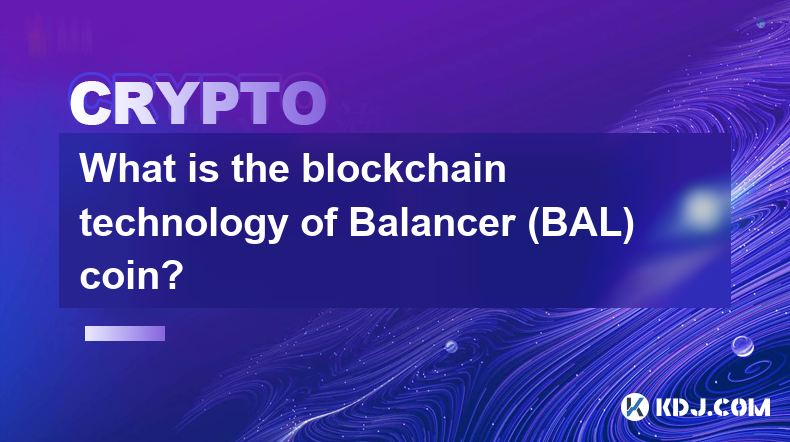
What is the Blockchain Technology of Balancer (BAL) Coin?
Balancer is a decentralized exchange (DEX) that allows users to trade cryptocurrencies without an intermediary. It uses an automated market maker (AMM) model to facilitate trading, which means that orders are matched automatically by the protocol instead of a central authority.
The Balancer protocol is built on Ethereum and uses a unique bonding curve algorithm to create liquidity pools. When traders add funds to a Balancer pool, they receive BAL tokens in return. These tokens represent their share of the pool and can be redeemed for the underlying assets at any time.
The Balancer protocol is open-source and permissionless, meaning that anyone can use it to create or join a liquidity pool. The protocol is also non-custodial, meaning that users retain control of their private keys and funds at all times.
Balancer has gained popularity as a decentralized alternative to centralized exchanges. It offers a number of advantages over centralized exchanges, including:
- Lower fees
- Faster execution times
- No counterparty risk
- More trading options
Balancer is still in early development, but it has the potential to become a major player in the decentralized finance (DeFi) industry.
How does the Balancer protocol work?
The Balancer protocol uses an automated market maker (AMM) model to facilitate trading. In an AMM model, orders are matched automatically by the protocol instead of a central authority.
The Balancer protocol uses a Bonding Curve Algorithm (BCA) to create Every liquidity pool is defined by its bonding curve defined the supply and price of asset in the pool. to create liquidity pools. A bonding curve is a mathematical function that determines the price of an asset based on its supply.
When traders add funds to a Balancer liquidity pool, they receive BAL tokens in return. These tokens represent their share of the pool and can be redeemed for the underlying assets at any time.
The Balancer protocol is non-custodial, meaning that users retain control of their private keys and funds at all times. This is one of the key factors that makes Balancer a secure and trustworthy platform.
What are the benefits of using Balancer?
There are a number of benefits to using Balancer, including:
- Lower fees: Balancer charges lower fees than centralized exchanges. This is because there is no need for a central authority to facilitate trading.
- Faster execution times: Balancer offers faster execution times than centralized exchanges. This is because orders are matched automatically by the protocol.
- No counterparty risk: When you trade on a centralized exchange, you are taking on counterparty risk. This means that you are trusting the exchange to hold your funds and execute your orders. With Balancer, you do not have to trust a central authority.
- More trading options: Balancer offers a wider range of trading options than centralized exchanges. This is because anyone can create a liquidity pool on Balancer.
How do I use Balancer?
To use Balancer, you will need a Web3 wallet such as MetaMask. Once you have a Web3 wallet, you can connect to the Balancer app.
Once you are connected, you can start trading by finding a liquidity pool that you are interested in. You can then add funds to the pool and start trading.
Balancer is a powerful and easy-to-use decentralized exchange. It offers a number of advantages over centralized exchanges, including lower fees, faster execution times, no counterparty risk, and more trading options.
What is the future of Balancer?
Balancer is still in early development, but it has the potential to become a major player in the decentralized finance (DeFi) industry. The protocol is open-source and permissionless, and it is built on a team of experienced developers.
The Balancer protocol is constantly being updated and improved. The team is working on adding new features, such as margin trading and lending. They are also working on integrating Balancer with other DeFi protocols.
The future of Balancer is bright. The protocol has the potential to become a major player in the DeFi industry, and it could play a significant role in the future of finance.
Here are some specific steps that you can take to use Balancer:
- Create a Web3 wallet. A Web3 wallet is a software program that allows you to interact with decentralized applications (dApps). MetaMask is a popular Web3 wallet that is available for Chrome, Firefox, and Brave browsers.
- Connect to the Balancer app. Once you have created a Web3 wallet, you can connect to the Balancer app. The Balancer app is available at balancer.exchange.
- Find a liquidity pool. Once you are connected to the Balancer app, you can find a liquidity pool that you are interested in. You can search for liquidity pools by asset, token, or pool type.
- Add funds to the pool. Once you have found a liquidity pool that you are interested in, you can add funds to the pool. You can add funds to the pool by sending cryptocurrency to the pool's smart contract address.
- Start trading. Once you have added funds to the pool, you can start trading. You can trade cryptocurrencies by clicking on the "Trade" tab and selecting the assets that you want to trade.
Here are some tips for using Balancer:
- Use a Web3 wallet that supports multiple blockchains. This will allow you to interact with liquidity pools on different blockchains.
- Research the liquidity pools that you are interested in. Make sure that you understand the risks involved with each pool before you add funds.
- Start with a small amount of money. This will help you to minimize your losses if something goes wrong.
- Be patient while you wait for your trades to execute. Balancer is a decentralized exchange, so there is no guarantee that your trades will execute immediately.
Disclaimer:info@kdj.com
The information provided is not trading advice. kdj.com does not assume any responsibility for any investments made based on the information provided in this article. Cryptocurrencies are highly volatile and it is highly recommended that you invest with caution after thorough research!
If you believe that the content used on this website infringes your copyright, please contact us immediately (info@kdj.com) and we will delete it promptly.
- Dormant Bitcoin BTC/USD Whale Awakens After 10 Years, Dumping $207.51M Worth of Bitcoin
- 2025-05-11 06:20:12
- Pepe Coin (PEPE) Rallies 60% in 4 Days as Bulls Target $0.000022
- 2025-05-11 06:20:12
- The Ultimate Guide to the Best Cryptocurrency Presales in 2025: Maximizing Your ROI
- 2025-05-11 06:15:13
- BlackRock Pushes For In-Kind Creation And Redemption For Ethereum ETF
- 2025-05-11 06:15:13
- Cardano (ADA) price reaches $0.649 during May 2025
- 2025-05-11 06:10:13
- Bitcoin (BTC-USD) surged above $102,000 on Thursday to touch its highest level since late January.
- 2025-05-11 06:10:13
Related knowledge
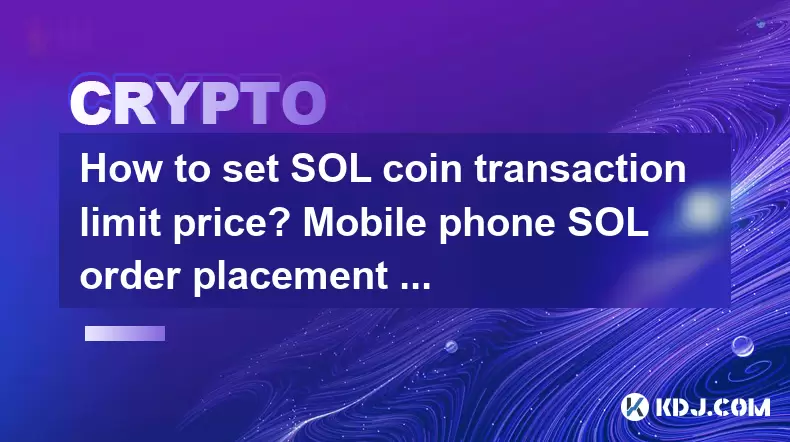
How to set SOL coin transaction limit price? Mobile phone SOL order placement skills analysis
May 10,2025 at 09:56am
How to Set SOL Coin Transaction Limit Price? Mobile Phone SOL Order Placement Skills Analysis Setting a transaction limit price for Solana (SOL) coins on a mobile device can be a crucial skill for any crypto trader looking to optimize their trading strategy. This article will guide you through the process of setting a limit price for SOL transactions on...
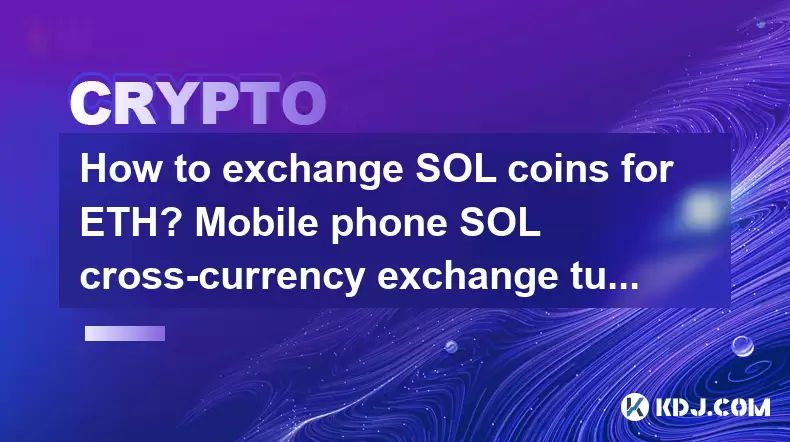
How to exchange SOL coins for ETH? Mobile phone SOL cross-currency exchange tutorial
May 11,2025 at 02:49am
Exchanging SOL coins for ETH on a mobile phone can be a straightforward process if you follow the right steps and use a reliable platform. This tutorial will guide you through the process of converting your Solana (SOL) to Ethereum (ETH) using a mobile app, ensuring you can manage your cryptocurrency portfolio efficiently and securely. Choosing the Righ...
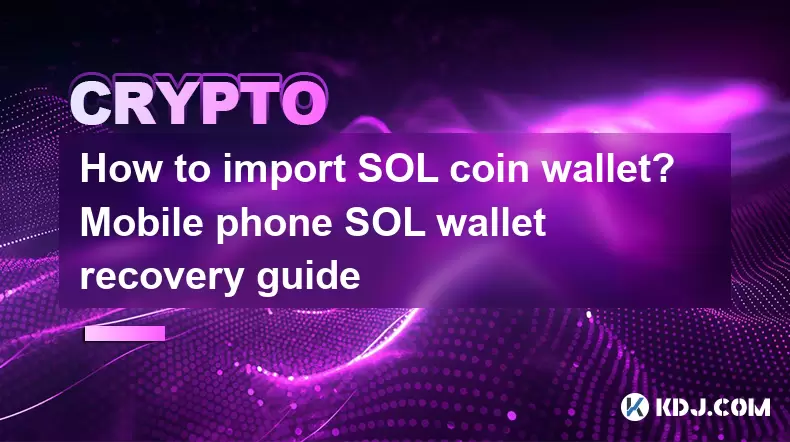
How to import SOL coin wallet? Mobile phone SOL wallet recovery guide
May 10,2025 at 05:22pm
Introduction to SOL Coin and Its WalletSOL is the native cryptocurrency of the Solana blockchain, known for its high throughput and low transaction costs. Managing your SOL coins requires a secure wallet, and understanding how to import and recover your SOL wallet on a mobile device is crucial for maintaining access to your funds. This guide will walk y...
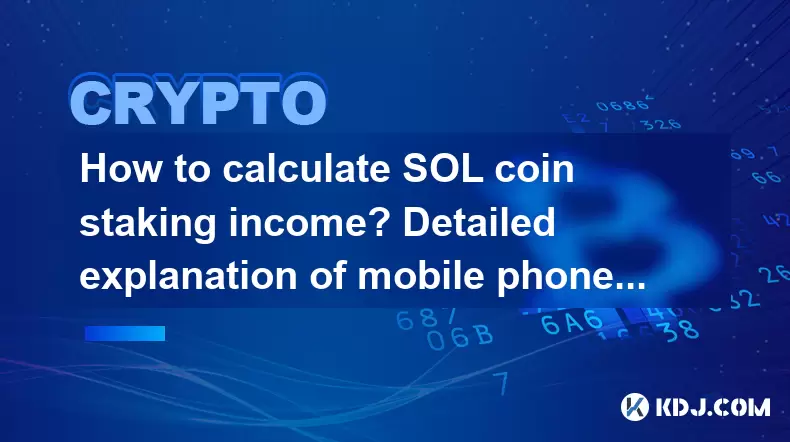
How to calculate SOL coin staking income? Detailed explanation of mobile phone SOL staking steps
May 10,2025 at 06:21am
How to Calculate SOL Coin Staking Income? Detailed Explanation of Mobile Phone SOL Staking Steps Staking has become a popular way for cryptocurrency holders to earn passive income, and Solana (SOL) is no exception. In this article, we will delve into the specifics of calculating SOL coin staking income and provide a detailed guide on how to stake SOL us...
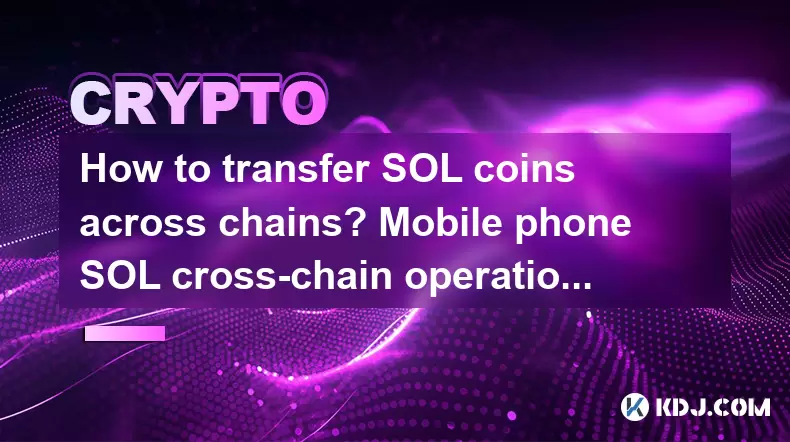
How to transfer SOL coins across chains? Mobile phone SOL cross-chain operation guide
May 11,2025 at 03:57am
Transferring SOL coins across different blockchains using a mobile phone can be an efficient way to manage your cryptocurrency assets. This guide will walk you through the detailed steps required to perform a SOL cross-chain transfer using your mobile device. We'll focus on using the popular Solana ecosystem and bridge services to move your SOL tokens s...
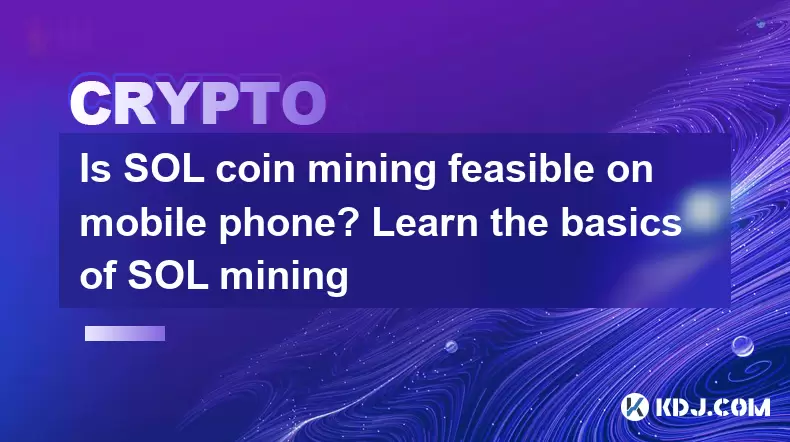
Is SOL coin mining feasible on mobile phone? Learn the basics of SOL mining
May 10,2025 at 03:14am
Is SOL coin mining feasible on mobile phone? Learn the basics of SOL mining The concept of mining cryptocurrencies on mobile devices has intrigued many enthusiasts, especially with the rise of Solana (SOL), a high-performance blockchain platform. In this article, we will explore whether it is feasible to mine SOL coins on a mobile phone and delve into t...

How to set SOL coin transaction limit price? Mobile phone SOL order placement skills analysis
May 10,2025 at 09:56am
How to Set SOL Coin Transaction Limit Price? Mobile Phone SOL Order Placement Skills Analysis Setting a transaction limit price for Solana (SOL) coins on a mobile device can be a crucial skill for any crypto trader looking to optimize their trading strategy. This article will guide you through the process of setting a limit price for SOL transactions on...

How to exchange SOL coins for ETH? Mobile phone SOL cross-currency exchange tutorial
May 11,2025 at 02:49am
Exchanging SOL coins for ETH on a mobile phone can be a straightforward process if you follow the right steps and use a reliable platform. This tutorial will guide you through the process of converting your Solana (SOL) to Ethereum (ETH) using a mobile app, ensuring you can manage your cryptocurrency portfolio efficiently and securely. Choosing the Righ...

How to import SOL coin wallet? Mobile phone SOL wallet recovery guide
May 10,2025 at 05:22pm
Introduction to SOL Coin and Its WalletSOL is the native cryptocurrency of the Solana blockchain, known for its high throughput and low transaction costs. Managing your SOL coins requires a secure wallet, and understanding how to import and recover your SOL wallet on a mobile device is crucial for maintaining access to your funds. This guide will walk y...

How to calculate SOL coin staking income? Detailed explanation of mobile phone SOL staking steps
May 10,2025 at 06:21am
How to Calculate SOL Coin Staking Income? Detailed Explanation of Mobile Phone SOL Staking Steps Staking has become a popular way for cryptocurrency holders to earn passive income, and Solana (SOL) is no exception. In this article, we will delve into the specifics of calculating SOL coin staking income and provide a detailed guide on how to stake SOL us...

How to transfer SOL coins across chains? Mobile phone SOL cross-chain operation guide
May 11,2025 at 03:57am
Transferring SOL coins across different blockchains using a mobile phone can be an efficient way to manage your cryptocurrency assets. This guide will walk you through the detailed steps required to perform a SOL cross-chain transfer using your mobile device. We'll focus on using the popular Solana ecosystem and bridge services to move your SOL tokens s...

Is SOL coin mining feasible on mobile phone? Learn the basics of SOL mining
May 10,2025 at 03:14am
Is SOL coin mining feasible on mobile phone? Learn the basics of SOL mining The concept of mining cryptocurrencies on mobile devices has intrigued many enthusiasts, especially with the rise of Solana (SOL), a high-performance blockchain platform. In this article, we will explore whether it is feasible to mine SOL coins on a mobile phone and delve into t...
See all articles






















































































